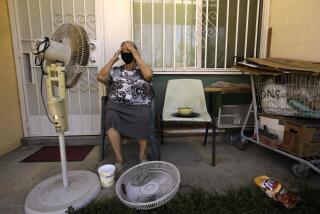Gold-covered nanoparticles might make cancer cells unable to stand the heat
- Share via
Scientists are turning up the heat on cancer with a one-two punch of radiation plus fever temperatures that could shrink stubborn tumors.
Drugs and radiation can beat back tumors, but some cancer cells usually survive the assault. So researchers at Baylor College of Medicine in Houston fortified their arsenal with gold-covered nanoparticles that embed themselves in tumors and bake them to temperatures of 108 degrees when activated with an infrared laser.
In their experiments, treating mice with heat plus standard radiation cleared breast cancer tumors better than either therapy alone. The researchers reported their results last month in Science Translational Medicine and hope to try the approach in people soon.
Heat disables cancer cells that are normally resistant to radiation, says molecular biologist Jeffrey Rosen, the study’s senior author. Once the cells are damaged, they become susceptible to the DNA-busting radiation treatment.
A lumpectomy is still the first line of defense against breast cancer, but this treatment could mop up any cancer cells that remain or recur. The therapy could also be useful for women whose tumors are so large they must be shrunk before surgery, Rosen says.
Max Wicha, a breast cancer stem cell researcher and director of the University of Michigan Comprehensive Cancer Center in Ann Arbor, added that other solid tumors might also be good targets for the nanoparticle treatment. Wicha is not involved in the Baylor study.
Indeed, researchers are pursuing a variety of treatment possibilities with gold particles because they are safe delivery vehicles. Gold does not react with molecules in the body, and the particles are naturally cleared from circulation.
Scientists are already testing heat-emitting gold particles that can fry head and neck cancers at temperatures exceeding 122 degrees Fahrenheit. The Baylor study is the first to suggest that a slightly gentler 108 degrees is sufficient to weaken the cells.
“Cancer cells develop a lot of resistance to therapies,” says Robert Getzenberg, a cancer biologist at the Johns Hopkins University School of Medicine in Baltimore, who also wasn’t involved in the study. “The price they seem to pay for that is sensitivity to changes in their environment,” including temperature.
Heat treatment is the kind of creative advance doctors need to vanquish cancer, says Getzenberg, who is working on similar therapies using iron beads to roast metastatic cancer.
A tumor is not a uniform blob; it’s made up of different kinds of cells fed by a network of blood vessels. Most of these cells fall to the medical onslaught of chemotherapy or radiation. But others — which some researchers think of as cancer stem cells — stand firm. Radiation damages their DNA, but they stitch it back together. These stem cells are the ones that multiply to make more cancer cells, so unless doctors can destroy them, tumors are likely to return.
Some scientists compare the challenge to weeding dandelions — regular drugs only lop off the flowers, but what matters are treatments that kill the stem cells that are the cancer’s root.
Rachel Atkinson, who recently earned her doctorate in Rosen’s lab, happened upon the heat idea while studying cancer stem cells in a dish. She hit the cells with 6 Grays of radiation — triple the standard dose in a hospital — but they wouldn’t die.
Then, one Monday morning, Atkinson was startled to find that the cells she’d irradiated on Friday had died over the weekend. It turned out that the incubator was accidentally cranked up from a balmy 98.6 degrees to a sweltering 108. The double whammy of irradiation plus heat knocked out the stem cells.
Although doctors have tried warming treatments before, past experiments were unsuccessful, Wicha says.
“They basically would warm up the patient’s whole body,” he says. But heat unravels the body’s proteins, damaging the heart and brain. “It was very toxic.”
Atkinson and Rosen knew they needed a way to cook the tumors without broiling the patient too. They found the answer at the nearby M.D. Anderson Cancer Center, where scientists had developed gold-coated nanoparticles that emit heat when excited by infrared laser light.
The scientists used 24 mice, each carrying a 1-centimeter tumor derived from mouse or human breast cancer, to test their theory. They injected the tiny gold beads into the animals’ veins, and since the blood vessels feeding tumors tend to be leaky, the nanoparticles spilled out and infiltrated the tumors. The next day, the scientists gave the mice 6 Grays of regular radiation treatment plus 25 minutes with an infrared laser targeted right at the tumors. Two days later, the animals had fewer cancer stem cells and smaller tumors compared with mice that received radiation alone.
The researchers suspect the heat interferes with the stem cells’ ability to fix broken strands of DNA. After Atkinson irradiated cancer stem cells in a dish, she looked under the microscope and saw the DNA repair machinery coalescing around broken areas. But in stem cells she both irradiated and heated, the repair machinery drifted aimlessly, unable to reach the sites of damage. With their genomes in pieces, the cells could not survive.
The heat treatment probably damages nearby blood vessels as well, so tumors can’t get the nutrients they need, the authors say.
In people, Rosen envisions a once-a-week heating treatment, lasting about half an hour, piggybacked onto a regular course of radiation. It’s not certain if patients would feel the warming, but scientists don’t think it would be too uncomfortable because the heated area is so small.
The infrared laser is harmless to healthy tissue. The main safety concern, Wicha says, is that the heat could damage nearby cells. But since the warming is precise, he believes the technique has promise.






